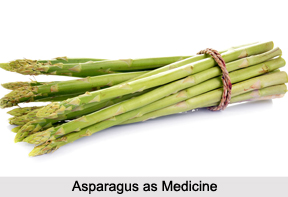 Asparagus Racemosus or Asparagus, the Sanskrit name is "Satamuli" which means possessing a hundred roots. It is in mention to the numerous fusiform tubers of this plant. The tubers are candied and taken as a sweet-meat.
Asparagus Racemosus or Asparagus, the Sanskrit name is "Satamuli" which means possessing a hundred roots. It is in mention to the numerous fusiform tubers of this plant. The tubers are candied and taken as a sweet-meat.
Benefits of Asparagus
Asparagus are regarded as cooling, demulcent, diuretic, tonic and aphrodisiac, and are used both internally and in the preparation of several medicated oils. The fresh juice of the root is given with honey as a demulcent in bilious dyspepsia or diarrhoea as an aphrodisiac tonic.
Dose of Asparagus in Medicine
Asparagus is used in a variety of forms as a medicine. A ghrita is prepared from Asparagus is as follows:
Satavari Ghrita: Take clarified butter 4 seers, juice of Asparagus racemosus 4 seers, milk 40 seers, boil them together and prepare a ghrita. This is given with the addition of sugar, honey and long pepper.
Phalaghrita: This is prepared with 4 seers of clarified butter and 16 seers each of the juice of Asparagus racemosus and cow"s milk, with the addition of a number of other medicines in small quantities, in the form of a paste. Its use is said to increase the secretion of semen, to cure barrenness in women and to remove disorders of the female genitals as a diuretic.
It is prescribed in combination with other medicines of its class. The following is an illustration; take the roots of Asparagus racemosus, Saccharum spontaneum (kasa), Poa cynosuroides (kusa), Oryza sativa (variety called salidhanya) and Saccharum officinarum (ikshu), Batatus paniculatus (vidari), Scirpus Kysoor (kaseruka), and Tribulus terrestris (gokshura) equal parts, and prepare a decoction in the usual way. This decoction is administered, with the addition of sugar and honey, in scanty urine with heat and ardor urinae. The juice of this drug taken with milk is useful in Gonorrhoea. The chief use of the drug however consists in the preparation of several popular cooling and emollient medicated oils for external application in disorders of the nervous system, rheumatic affections and urinary diseases.
Narayana Taila popularly known as Madhyama Narayana Taila is made by taking of the bark of Aegle Marmelos (vilva), Premna spinosa (agnimantha), Calosanthes Indica (syonaka), Stereospermum suaveolens (patala), Erythrina Indica (paribhadra) Poederia fostida (prasarani), Withania somnifera (asvagandha), Solatium Jacquinii (kantakari), Solanum Indicum (vrihati), Sida cordifolia (bala), Sida rhombifolia (atibala), Tribulus terrestris (danshtra) and Boerhaavia diffusa (punarnava), each 20 tolas, water 64 seers, and boiling down till reduced to one-fourth and straining. To the strained decoction add 4 seers each of the juice of Asparagus racemosus and prepared sesamum oil, 16 seers of cow or goat"s milk and the following substances, namely, fennel seeds, wood of Cedrus Deodara (devadaru), Jatamansi root, liquid storax, Acorus Calamus (vacha), sandal wood, Limnanthemum cristatum (tagarapaduka), Aplotaxis auriculata (kushtha), cardamom, Desmodium gangeticum (salaparni), Uraria lagopodioides (prisniparni), Phaseolus trilobus (mudgaparni), Glycitie labialis (mashaparni), Wiihania somnifera (asvagandha), Vanda Roxburghii (rasna), Boerhaavia diffusa (punarnava) and rock salt, 4 tolas each in the form of paste and prepare an oil in the usual way. When ready, boil again with fragrant substances as directed in the introduction under the head of medicated oils. This oil is much used by native physicians in rheumatism, diseases of the joints, stiff neck, hemiplegia and other diseases of the nervous system.
Vishnu Taila: This oil is much used in nervous diseases. It is prepared with sesamum oil, cow or goat"s milk, and the juice of Asparagus racemosus, with the addition of a number of substances in small quantities in the form of a paste.
Prameha Mihira Taila: This oil is prepared with the juice of Asparagus racemosus sesamum oil, decoction of lac, whey and milk with the addition of a number of substances in the form of a paste. It is rubbed on the body and more particularly over the pubic region in chronic gonorrhoea, stricture of the urethra and other diseases of the urinary organs.




















